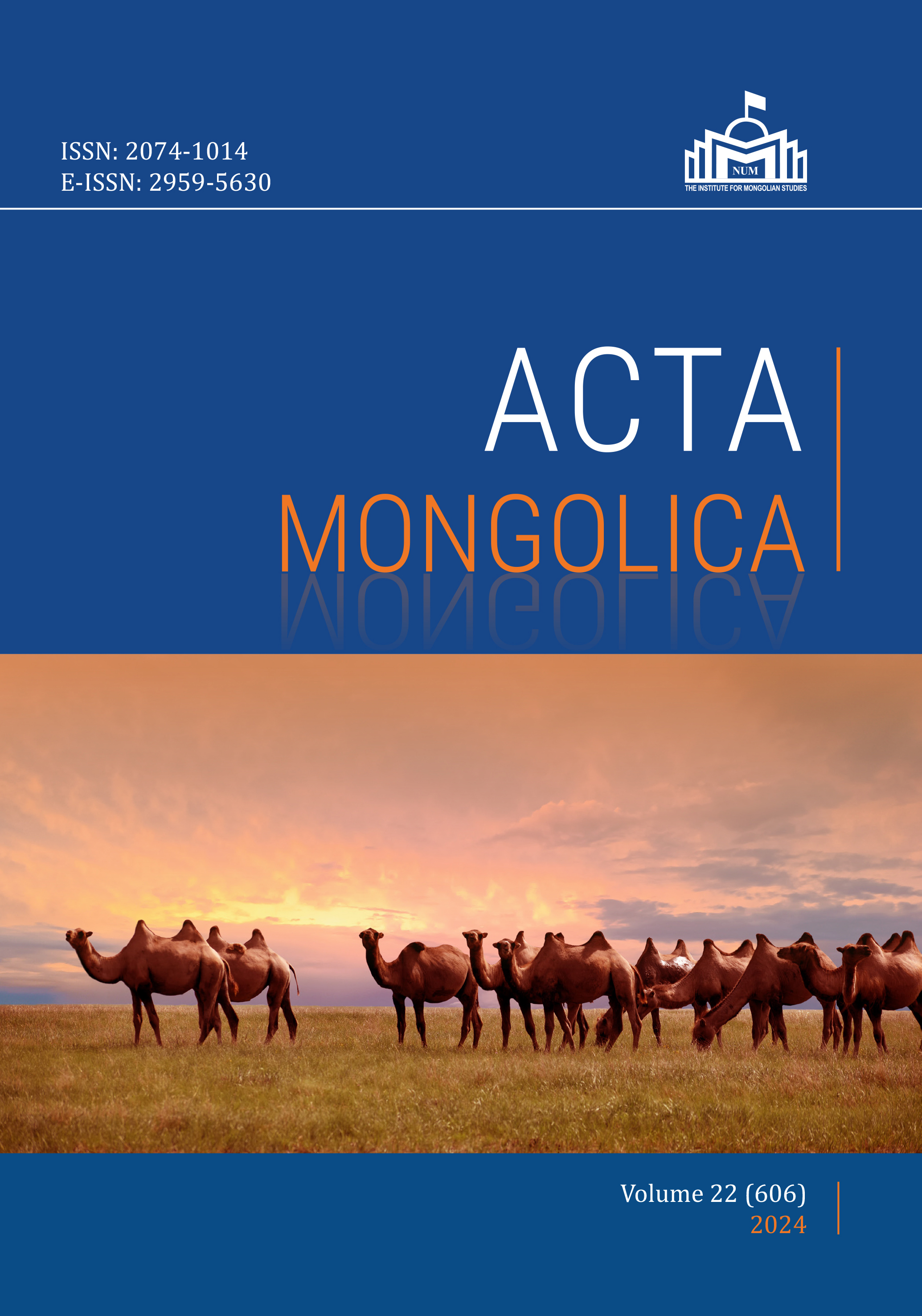The Moral Force of Labor in Mongolia's Late-stalinist Literature
Main Article Content
Abstract
The Mongolian people expect to see in art and culture the true situation in this new era, and to feel the greatest satisfaction. They want literature and art, in the broadest possible terms, to express the ideology and culture which they so value. As Comrade Zhdanov has said, “Our people’s spiritual wealth is no less important than their material wealth.” In addition to the important changes which have altered the face of our nation, we have also continued to change ourselves, and it is important that literature portrays these new qualities of our people. Literature should show our people not only as they are today, but also how they will be tomorrow, thus illuminating their path ahead. This is the honorable role of Mongolian writers. Writers are not dragged along by what might happen, but rather they lead the people, and show them the path of progress.
Article Details

This work is licensed under a Creative Commons Attribution-ShareAlike 4.0 International License.
References
Baast, B. Tolbo Nuur [Lake Tolbo]. 1947. Ulaanbaatar: Ulsyn Hevleh Üildver.
Baatar, Ya. 2016 Guchaad on, dörvön Chimid [Four Chimids from the Thirties]. San Francisco, n.p.
Bawden, Charles. 1989. The Modern History of Mongolia. London: Kegan Paul International.
Chutkikh, Alexander. 1951. Top-Quality Team. Moscow: Foreign Languages Publishing House.
Clark, Katerina.1997. “Utopian Anthropology as a Context for Stalinist Literature.” In Robert C.Tucker Stalinism: Essays in historical interpretation. New Brunswick: Transaction Publishers, pp.180-198.
Dagvadorj, Ch. 1983. Mongolian orchin uyeiin uran zohiol dahi ajilchin angiin düriin högjil. [The Development of Characters in the Laborer Class in Mongolia’s Contemporary Literature] Ulaanbaatar: Ulsyn hevleliin gazar.
Damdinsüren, Ts. 1956. Tüüver zohiol [Collected Works]. Ulaanbaatar: Ulsyn hevleliin gazar.
Darjaa, D. 1951. “Damirangiinhan”. Hödölmör (43).
Dashdendev, S. 1949. “Huv’sgalt urlag utga zohiol bol manai namyn üzel surtlyn zevseg mön” [“Revolutionary art and literature is the ideological weapon of our Party”]. Tsog 3 (18), pp.3-18.
Development of the National Economy and Culture of the Mongolian People’s Republic from 1921 to 1958: A statistical compilation. 1961. Washington DC: US Joint Publications Research Service.
Dobrenko, Evgeny. 2007. Political Economy of Socialist Realism. New haven: Yale University Press.
Gruber, A.A. (Editor). 1973. History of the Mongolian People’s Republic. Moscow: Nauka. History of the Mongolian People’s Republic. Moscow: Nauka Publishing House.
Huvisgal-un uran jokiyal [Revolutionary Literature]. 1932. Ulaanbaatar: n.p.
Horloo, P. 1948. Realizm gedeg yuu ve? [What is ‘Realism’?] Tsog, 2:14, pp.39-45.
Jigmed, Ch. 1978. Az jargal [Happiness]. (Ulaanbaatar: Ulsyn Hevleliin Gazar)
Mongolyn shildeg ögüülegüüd [Mongolia’s Best Short Stories]. 1961. Ulaanbaatar: Ulsyn hevleliin gazar.
Mongolyn zohiolchdyn anhdugaar ih hural [The First Congress of Mongolian Writers]. 1948. Ulaanbaatar: Sühbaataryn neremjit Ulsyn Hevleh üildver.
Mönh, Ts. 1961. “Ajilchny tuhai manai zohiolchdyn büteel” [“Texts about Workers by Our Writers]. In Ts.Mönh, Shine uran zohiolyn zarim asuudal [Some Questions Regarding the New Literature]. Ulaanbaatar; Shinjleh Uhaan Akademiin Hevlel)
Natsagdorj, Sh. (Ed.). 1986. BNMAU-yn soyolyn tüüh (1941-1960) [The Cultural History of the Mongolian People’s Republic 1941-1960]. Ulaanbaatar: Ulsyn Hevleliin Gazar.
Sengee, D. 1978. Büteeliin tüüver [Collected Works]. Ulaanbaatar: Ulsyn Hevleliin Gazar.
Siegelbaum, Lewis H. 1988. Stakhanovism and the Politics of Production in the USSR 1935-1941. Cambridge: Cambridge University Press.
Shlapentokh, Vladimir. 1988. “The Stakhanovite Movement: Changing Perceptions over Fifty Years.” Journal of Contemporary History, Vol. 23, No. 2, Bolshevism and the Socialist Left (Apr., 1988), pp.259-276.
Tarva Dalantain. 2020. Damirangiinhan. Ulaanbaatar: Soyombo Printing.
Tsedenjav, Ts. 2018. Roman, tuuj, ögüülleg, ögüülel, dursamj [Novels, novellas, short stories, articles, memoirs]. Ulaanbaatar: n.p.
Tsedev, D. 2016. D.Natsagdorj: Büren zohiol [D.Natsagdorj: Complete Works]. 2 Vol. Ulaanbaatar: n.p.
Udval, S. 2001. Narny dor bi mönh orshino [I Will Forever Be In the Sun]. Ulaanbaatar: n.p.
Ulambayar, Ts. 1974. Tüüver zohiol [Collected Works]. Ulaanbaatar: Ulsyn hevleliin gazar.
Utga zohiolyn unshih bichig - dund surguuliin 7dugaar angid uzne [A Literature Reader for 7th Grade Students]. 1956. Ulaanbaatar: Ulsyn hevleliin gazar.
Veselá, Pavla. 2003. “The Hardening of ‘Cement’: Russian Women and Modernization.” NWSA Journal, vol. 15, no. 3, pp. 104–23.
Wickhamsmith, Simon. 2020. Politics and Literature in Mongolia (1921-1948). Amsterdam: University of Amsterdam Press.
Wickhamsmith, Simon (trans.). 2021. Suncranes and Other Stories: Modern Mongolian Short Fiction. New York: Columbia University Press.
Yadamsüren, M. 1970. Tüüver sohiol [Complete Works], Ulaanbaatar: Ulsyn hevlelyn gazar
Zhdanov, A.A. 2022. On Literature, Music, and Philosophy. Toronto: November 8th Publishing House

